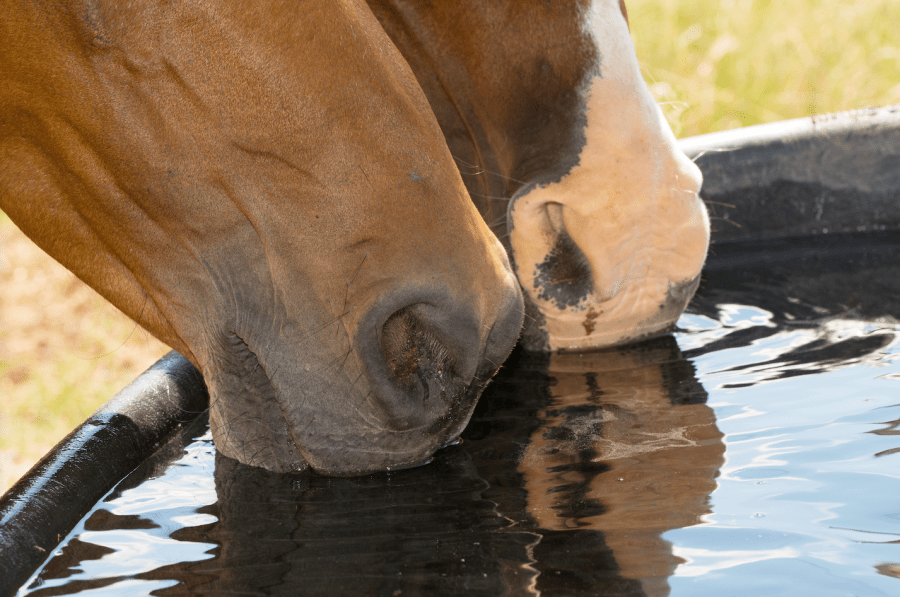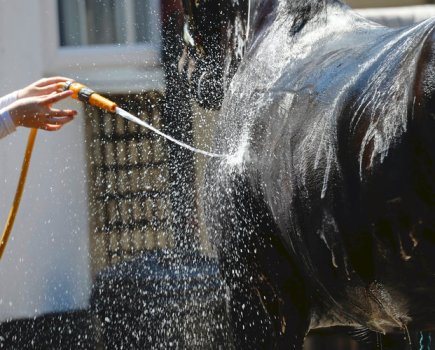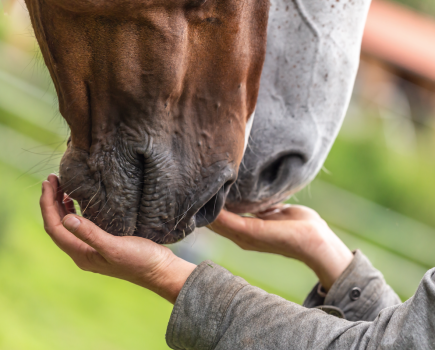On hot sunny days when temperatures are high, ensuring your horse drinks enough is top of every owner’s priority list because a dehydrated horse quickly becomes very unwell.
They say you can lead a horse to water but you can’t make them drink and it’s true — they’ll only gulp it down if they want to. However, there are several things you can do to increase your horse’s water intake and keep their hydration levels up…
Freely available water
The average horse will drink around 10 to 12 gallons of water a day, though just like us their thirstiness levels will vary.
You only have to look at the water buckets in a typical yard to see that some horses will drain two big buckets overnight, while others will hardly have touched theirs.
To be on the safe side, it’s best to follow the old Pony Club mantra that fresh, clean water should always be freely available and scrub out water troughs and buckets regularly.
Consider giving them a larger water bucket so that they have some left when you next visit rather than risk them running out.
If you use automatic drinkers in your stable and troughs outside, bear in mind you won’t be able to gauge how much they’ve actually been drinking.
It’s also a good idea to take water from home with you to a show or event. Many horses don’t like the taste of ‘strange’ water and will refuse to touch it out of a different tap or hose.
Flavoured water
Water is great for quenching thirst, but sometimes adding a little something sweet so that it tastes nicer is necessary in order to encourage a horse to drink more of it.
Things to consider adding are apple juice or sugarbeet water to the bucket.
There are products available to tempt fussy horses to drink more too, such as Horse Quencher.
If you’re trying it for the first time, though, our top tip is to provide plain water in a separate bucket too. This way, if your horse doesn’t like the ‘tasty’ water, they still have something to drink.
Soaked feeds
A soaked feed is a really useful addition to every horse’s diet, because it boosts water intake and helps to keep them hydrated.
There are plenty on the market to choose from — but make sure you introduce a new feed to your horse gradually. This is very important.
If you’re not adding water via a soaked feed, then adding water from the tap and mixing it in by hand is better than nothing.
A sloppy mash can be quite appealing to horses and is an effective way to increase their water intake and prevent dehydration.
Swap hay for haylage
Haylage contains more water than hay and so can be fed instead to aid hydration levels.
However, one of the golden rules of feeding horses is to make changes to their diet very slowly. So if your horse only ever eats hay, introducing them to haylage on a very hot sunny day may not be the best time to do it.
Sudden dietary changes upset the digestive system and increase the risk of serious conditions like colic and diarrhoea occurring.
Also bear in mind that haylage may not be suitable for all equines, so do what is best for your own horse.
Contrary to popular belief, haylage is normally lower in sugar than hay and it contains more protein.
However, soaking or steaming hay can help to reduce its sugar levels.
Shade
The golden rule, in case you missed it, is that horses should have access to clean, fresh water all of the time.
This applies all year round, because winter dehydration is a risk too.
Soaking hay will also help to increase its water content, but bear in mind it will affect its nutritional value too.
It is also important that your horse has access to shade so that they can get out of the sun if they want to.
It might be in the form of trees, a field shelter or being stabled by day and turned out at night.
Whatever you choose, make sure your horse can escape the sun when they want to.
Electrolytes
On very hot days, it is best to either not ride or, if you really have to, go out very early in the morning or late in the evening when the air is cooler.
Horses lose vital minerals — called electrolytes — in their sweat and urine, which water alone can’t replace.
Salt (or sodium chloride to give it its technical name) is the most important of all the electrolytes.
Others include magnesium, calcium, phosphorous, chloride and potassium.
Electrolyte supplements contain a mix of some or all of these minerals in a bid to restore the horse’s natural balance and they work in two ways:
- They replace lost salts and other minerals.
- They help to prevent dehydration by encouraging the horse to drink.
It’s very important that electrolytes are given alongside sufficient levels of water.
Feeding them in a concentrated form, without the water, risks further dehydrate the horse.
So whether you give them in a very sloppy feed or dissolve them in a bucket of water, it’s important your horse always has plenty to drink.
The easiest way to give vital minerals is via a salt or electrolyte lick in the field or stable so your horse has free access.
You don’t need to ‘load them up’ prior to peak exercise, but if your horse is working hard and sweating up regularly — or there’s a long spell of hot weather — it’s beneficial to give electrolytes as a matter of course.
A horse’s normal diet doesn’t provide enough salt as it’s impossible to put sufficient levels in a bagged feed.
So generally, experts recommend feeding normal salt day to day, ideally in lick form.
You can then ‘upgrade’ to the electro-salts (or electrolytes) at peak times after exertion.
If they won’t use a lick, you can add salt to their diet at a rate of around 25-30g a day for a 500kg horse.
Signs of dehydration
The first signs of dehydration are often reduced stamina and loss of performance, before further health problems step into the fray.
A pinch test can show early signs of dehydration. To do this, simply pinch the skin and if, when you let go, it doesn’t immediately go back to being flat, it could be an indicator that your horse is dehydrated.
If you allow this to continue without putting it right you’re looking at side-effects like poor recovery from exercise, muscle damage and tying up (or azoturia).
Long-term, repeated dehydration could result in serious problems, such as bone and tissue damage within the system.
In the short-term, lethargy and poor recovery from exercise are the most common signs.
Main image © Shutterstock









